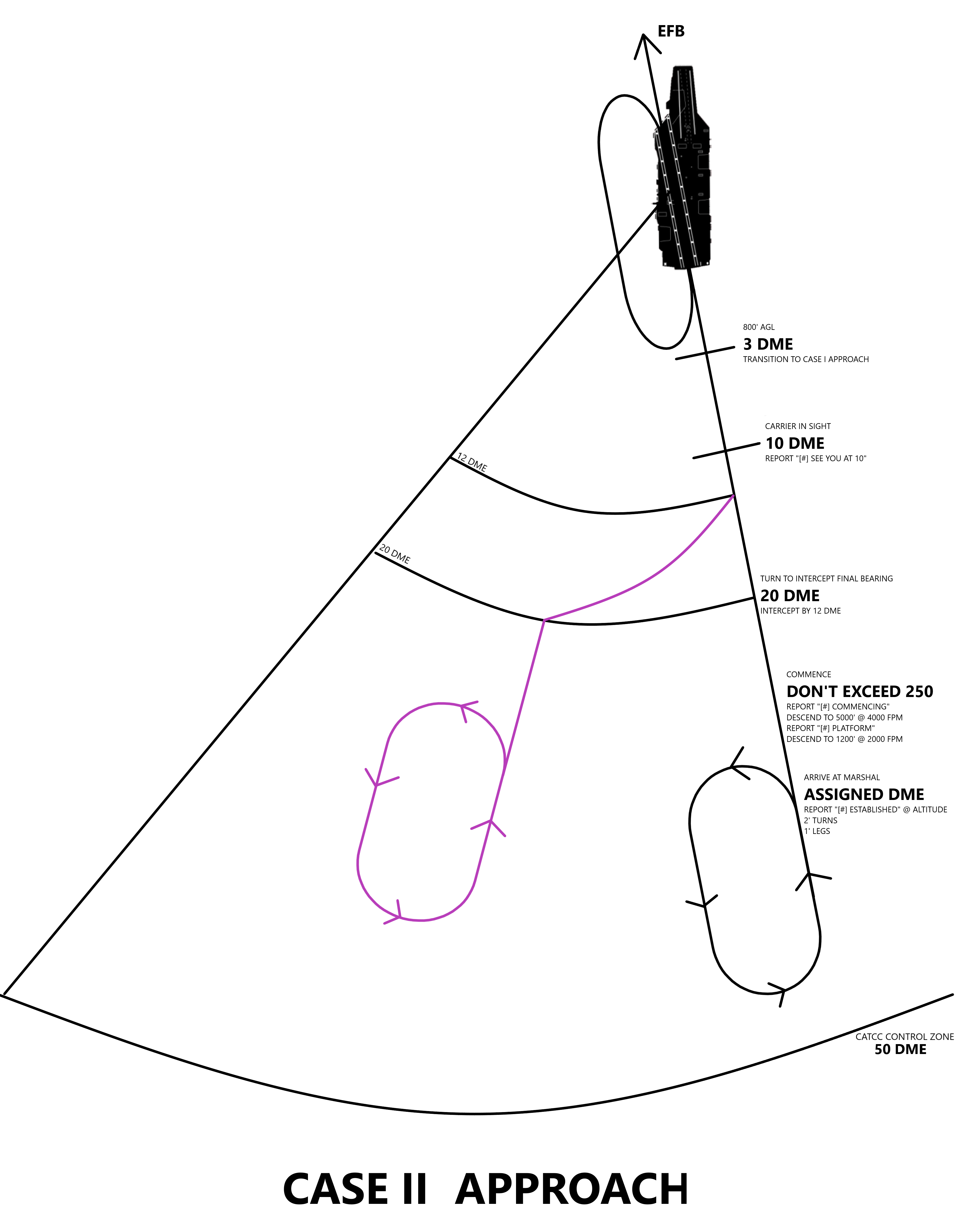¶ vCSG-8 Carrier Procedures
The vCSG-8 Carrier Procedures page is the home page for all operational procedures occurring on the flight deck of the aircraft carrier and within the Carrier Air Traffic Control Center’s (CATCC) zone of responsibility. As of April 29th, 2024, vCSG-8 does not utilize, teach, or expect members to know how to perform a CASE II launch or recovery pattern, nor the CV-2 approach in either a CASE II or III recovery.
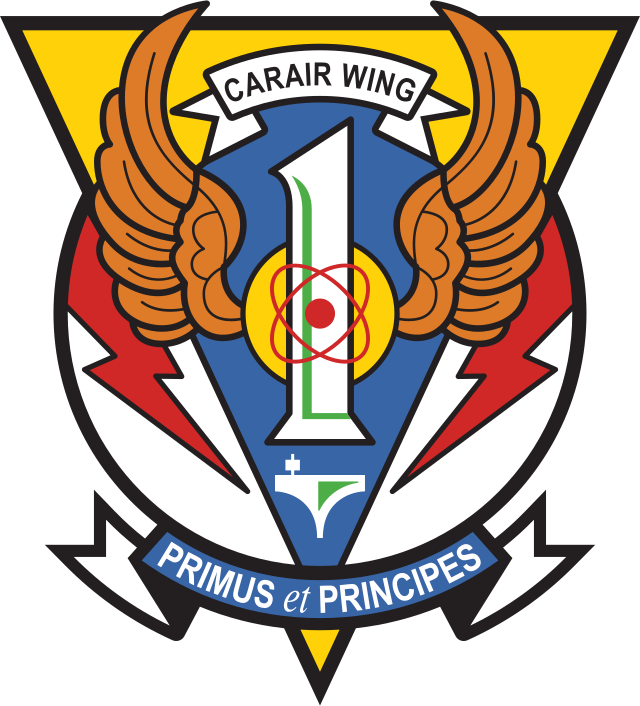
¶ I - Deck Operations
To facilitate a speedy start to the mission, every aircraft must perform their required tasks and vacate the flight deck in a timely manner. Due to how the DCS: Supercarrier interacts with the F-14 Tomcat, if so much as ONE (1) F/A-18C Hornet spawns on the aircraft carrier, all subsequent F-14 Tomcats attempting to spawn will get the “FLIGHT DELAYED TO START” message. This message carries the potential to double the weight of the affected Tomcat’s ordnance.
Be courteous to your community members and clear the deck ASAP. Nobody likes waiting 50 minutes in spectator mode.
¶ 1.1 Aircraft Configuration
Once the game has fully loaded your aircraft on the carrier, configure your aircraft with the following information:
- Open the Rearm & Refueling window with Left Alt + ', confirm your loaded ordnance aligns with what was briefed either by the mission commander or flight leader.
- Change your livery and modex number to be congruent with your assigned modex in the flight composition tab of the roster.
- Set
MIDS Bto the frequency assigned from the communication plan in the mission briefing materials, or the vCSG-8 communication plan VICTORIA page if no specific plan was provided.- Perform a radio check on
MIDS B: “#, radio check on {Radio Freq}.”
Two, radio check on MIDS B
- Perform a radio check on
- Once you feel you are ready for taxi, on
MIDS Bcall out: “#, green jet.”Two, green jet
Once the game has fully loaded your aircraft on the carrier, configure your aircraft with the following information:
- Open the Rearm & Refueling window with Left Alt + ', confirm your loaded ordnance aligns with what was briefed either by the mission commander or flight leader.
- Change your livery and modex number to be congruent with your assigned modex in the flight composition tab of the roster.
- Set
MIDS Bto the frequency assigned from the communication plan in the mission briefing materials, or the vCSG-8 communication plan VICTORIA page if no specific plan was provided.- Perform a radio check on
MIDS B: “#, radio check on {Radio Freq}.”
Two, radio check on MIDS B
- Perform a radio check on
Once the game has fully loaded your aircraft on the carrier, configure your aircraft with the following information:
- Open the Rearm & Refueling window with Left Alt + ', confirm your loaded ordnance aligns with what was briefed either by the mission commander or flight leader.
- If carrying laser-guided ordnance, confirm or modify your laser code by opening your kneeboard using Right Shift + K. Consult the Laser Code Deconfliction Plan VICTORIA page or the mission briefing to find your correct code.
- Change your livery and modex number to be congruent with your assigned modex in the flight composition tab of the roster.
Open the canopy slightly or switch your
INTERPHONEmicrophone toHOT MICto hear the crew chief tell you when rearming is complete.
- Tune the
FRONT RADIOtoPreset 3and verify the frequency matches the mission briefing materials by selectingREADon theFRONT RADIOcontrol panel, or set as prescribed by the vCSG-8 communication plan VICTORIA page if no specific plan was provided.- Perform a radio check on the
FRONT RADIO: “[flight name, position], radio check on {Radio Frequency}.”
Ripper Two, radio check on two seven five point zero.
- Perform a radio check on the
- Once you get confirmation from the crew chief, request taxi to a catapult if the carrier has a human controller, otherwise taxi at your discretion.
¶ 1.2 Taxi
Once your aircraft is configured to the absolute minimum required to leave the deck, request a taxi to launch on Preset 1 during a CASE I/II departure, or Preset 2 during CASE III conditions. It’s a good idea to include relevant information to your starting location, but if you do not know the exact name, you can use simple English.
409, ready to taxi from elevator four.
100, ready to taxi from behind the tower. [1]
Follow all taxi commands given by Tower or Departure and line up for your assigned catapult.
¶ Uncontrolled Deck
When no deck controller is available to deconflict deck operations, aircraft should remain vigilant for any traffic around their aircraft. When ready to taxi, call over the Tower frequency and announce your itentions to taxi. Effort should be made to take the most direct route to the nearest catapult.
¶ Taxi Safety Considerations:
To avoid issues with the carrier deck crew not responding and thus disabling ALL catapults, Tomcats should only utilize catapults One (starboard bow) and Three (starboard waist).
- Ensure anti-skid is OFF
- Max engine RPM for taxiing will be 75%
- All turns will be made with power at idle
- Wings should remain folded until crossing the jet blast deflector prior to catapult hook-up
¶ II - CASE I
¶ 2.1 Launch
When you’re in tension and the shooter is giving you the spool up command, request a launch from Carrier Tower on Preset 1during CASE I conditions
321, ready to launch cat one.
To avoid issues with the carrier deck crew not responding and thus disabling ALL catapults, it is highly encouraged for Tomcats to utilize catapults One (starboard bow) and Three (starboard waist) only.
Salute the shooter to launch, and once you have achieved positive rate of climb, execute a clearing turn to the right if launched from the bow, left if launched from the waist then parallel BRC. Maintain 500 feet at 300 knots until 7 DME from the carrier, then proceed on mission
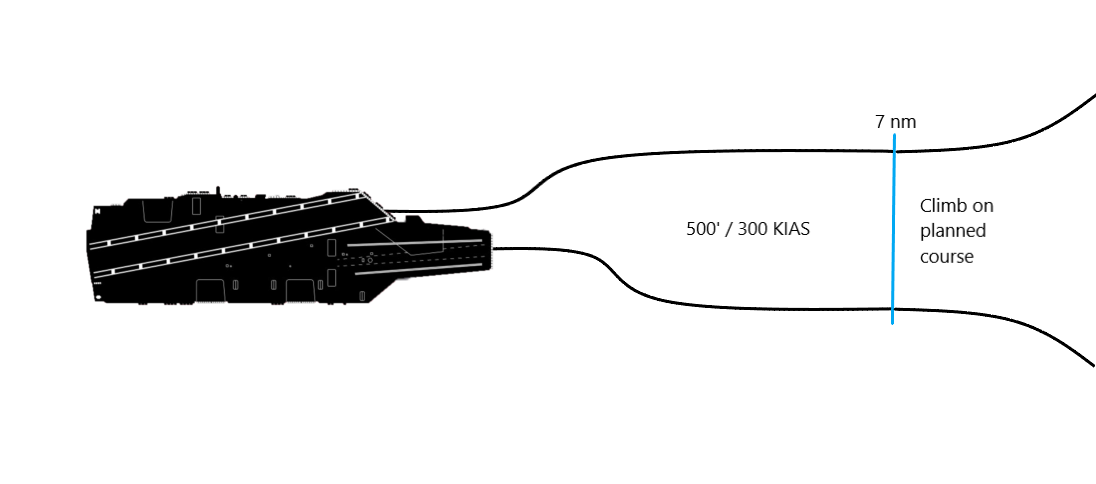
¶ 2.2 Arrival
Before you are able to give the relevant information to the CATCC, you should configure your jet for landing on the carrier. For all aircraft this includes tuning one radio to the marshal frequency, which is Preset 19 for all radios on all aircraft that vCSG-8 uses. Configure your TACAN to show you the direction and distance towards the current carrier in use for the mission. The TACAN frequency can be found in the mission briefing material. Enable all external lights and deploy your landing hook now so you have less items to check off of your list as you’re landing.
Due to Visual Flight Rules (VFR) allowing for more relaxed flying, performance of the mentioned information should be done to the best of your ability and is not make-or-break for qualifications or weekly operations.
At 50 NM, begin the check-in call. The check-in assists CATCC with locating you on their radar scope, allowing them to place you into the overhead stack at the ideal altitude and ensure smooth flow of the landing pattern. CATCC will inform you of current Visual Flight Rule (VFR) conditions over the carrier, assign you a holding altitude, and request that you notify them you have visual of the aircraft carrier by no-later than 10 DME. In some cases, CATCC will not assign a holding altitude, in which case default to your squadron’s standard hold altitude.
Marshal,
[Modex], marking mom’s[Bearing from CVN to aircraft]for[range], angels[current altitude], state[remaining fuel in pounds, divided by 1000].
Marshal, 404, marking mom’s Zero Three Zero for Fourty-Nine, angels One Six, state Four point Zero.
[Modex], mother’s weather is[visibility], [cloud ceiling, if cloudy], altimeter[pressure inches mercury], CASE I recovery expected, BRC[carrier heading]. Marshal angels[altitude in thousands of feet]. Report see me at 10.
404, mother’s weather is clear, Ten plus miles, altimeter Two Niner Niner Two. CASE I recovery expected, BRC One One Five. Marshal angels Three. Report see me at 10.
Respond with your [Modex] to let CATCC know that you heard and understood their instructions and begin a descent to your holding altitude. As you approach the 10 mile carrier control zone at your assigned altitude, notify CATCC when you have visual of the carrier with [Modex], see you at [distance], with the minimum required distance being 10 DME. CATCC will request a fuel update and inform you to switch to the tower channel, assuming said channel is in use during recovery.
404, see you at Nineteen.
404, update state, switch tower.
404, state Three point Two.
Now that you are at your holding altitude and within sight of the carrier, you will now enter the overhead stack. The preferred positions to do this are Positions 1 and 3, with a 45º angle entrance. Mainting a left hand orbit at 250 knots, with Position 1 roughly 1 DME starboard of the carrier, and Position 3 roughly 5 DME port of the carrier. Once you have entered this stack, report Tower, [Modex], overhead angels [altitude in thousands of feet], state [fuel remaining in pounds, divided by 1000].
Tower, 404, overhead angels Three, state Three point Zero.
When descending through the stack, pilots are permitted to descend between Position 3 and Position 1, behind the carrier. When in a heavily occupied stack, flights must descend in blocks of 1000 feet. If there are gaps in altitude, flights are allowed to descend as needed to close the distance. As an example, Flight 1 is at 5,000 feet while Flight 2 is at 2,000 feet. Flight 1 can proceed all the way down to 3,000 feet, completely skipping having to make an orbit at 4,000 feet. If you must ascend, this is done in front of the carrier in between Position 1 and Position 3.
¶ 2.3 Recovery and Bolter Pattern
When the aircraft carrier is ready to recover aircraft, the tower controller will inform the overhead aircraft with the phrase [Modex], BRC is [carrier heading]. Your signal is Charlie. In this case, Charlie means that you are Clear to land. If this phrase is directed at a specific aircraft, the mentioned modex should respond with their number to indicate that they received and understood the instruction. If the tower controller says Ninety-Nine instead of a specified modex, that indicates the call is going out to all aircraft and everyone is allowed to land, so long as they adhere to the order of the stack. Proper interval is to begin commencing when the flight ahead of you is entering the break. In a Zip-Lip recovery, flights are to begin recovering once the recovery window has opened at the pre-briefed time.
As you approach Position 3, depart from the stack heading 210º left from BRC, or a 30º offset to the right of the reciprocal heading. Begin your descent to 800 feet while accelerating your aircraft to 350 knots. When 7 DME from the carrier, begin banking to the left to align yourself with the BRC of the carrier. If done properly, you should end up 3 nautical miles astern of the carrier.
If a human Landing Signal Officer has been briefed or announced some time during recovery, tune a radio to the tower frequency if not already directed to during your entrance to the stack.
F-14 Tomcats should manually sweep their wings back to Full Sweep (68º) at this point, to allow time for the actuation of the hydraulics to complete before rolling out on BRC.
Maintaining 800 feet and 350 knots, pass the carrier’s starboard side within one quarter of a mile. Begin your landing sequence with a level left hand break and the radio call [Modex], in the break, only if the LSO is not currently directing any aircraft in for a landing. In Zip-Lip procedures, do not make this call. Some information on when to break;
- As the wingman in a flight of two or more aircraft, count 17 seconds before making your own
in the breakcall and beginning your own landing configuration. If you cannot break before 4 nautical miles upwind of the carrier, depart the stack and transition to a CASE I departure, and restart the marshall process. - As a flight lead, begin your break as soon as you are able, with the minimum distance being at the bow of the ship itself if leading a flight of four, with the maximum distance being one nautical mile ahead of the ship. You may extend the initial break distance by one quarter mile for every missing aircraft. This rule is in place to prevent the fourth member of the flight from having to configure for landing seven miles upwind of the carrier and drawing out the whole landing ordeal.
With your level left hand break, pull your aircraft to maintain G-forces equalling 1% of your airspeed (350 knots = 3.5 Gs). At the same time, deploy your speed brake. At 250 knots, deploy your landing gear and landing flaps. Level off on the reciprocal of the BRC and maintain 600 feet MSL. You should be approximately 1-1.5 DME from the aircraft carrier. Confirm the following:
- Gear down and locked
- Full Flaps
- Hook down and locked
- Radio tuned to the correct frequency
With your level left hand break, deploy your speedbrack and pull your aircraft to maintain G-forces equalling 1% of your airspeed (350 knots = 3.5 Gs). At 275 knots, select Auto Sweep to bring the wings full forward to 20º. At 250 knots, deploy the landing gear. At 225 knots, select full flaps down. When the nose gear locks into place, select Direct Lift Control (DLC). Roll out on the reciprocal of the BRC and maintain 600 feet MSL. You should be approximately 1-1.2 DME from the aircraft carrier when abeam the stern (your cue to begin your turn to final). Confirm the following:
- Gear down and locked
- Full Flaps
- Speed Brake extended
- Direct Lift Control (DLC) deployed
- Hook down and locked
- Radio tuned to the correct frequency
Passing the Landing Signal Officer (LSO) station at the stern of the aircraft carrier, begin turning in for your landing. If this seems too soon, the forward motion of the ship will provide distance to allow you time to line up for a safe and successful recovery. As you approach the the 90º point of your turn, you should begin looking at the ship more than your instruments. Use the Improved Fresnel Lens Optical Landing System (IFLOLS) to assess your height and the centerline markings on the deck to assess lineup. When you roll wings level (ideally at three quarters of a mile) evaluate if you can see the orange light on the IFLOLS (known as the meatball). If you can, inform the LSO with [Modex], [aircraft type], BALL, state [fuel remaining in pounds, divided by 1000]. If you cannot see the ball, replace ball with CLARA, indicating to the LSO they should guide you to a point where you should be able to see the ball.
Make any corrective actions the LSO informs you of and recover the aircraft on the carrier. There’s no fancy magic the pilot is required to know here, the LSO gives you information as if they were flying the plane. If the LSO says Come left, simply nudge your plane a little to the left. Their tone and rate of instruction provide the speed and amount of adjustment you should make.
Regardless of whatever reason that caused a failure to trap, maintain the final bearing of the carrier’s landing area while climbing back to 600 feet MSL at max power. Remain in landing configuration, and when at altitude turn to parellel BRC.
If the carrier is not in Zip-Lip procedures, you may be directed when to turn downwind to approach again. Otherwise, you must determine your interval. If you boltered while another aircraft was in the break, the first aircraft/flight to reach the bow has right of way, and the other aircraft must get behind that aircraft or flight. If you have right of way, turn downwind once at 600 feet MSL and 1 DME upwind, if not continue parallel BRC until that aircraft is over your left horizontal stabilizer to form the proper interval.
¶ III - CASE III
¶ 3.1 Launch
When you are in tension and the shooter is giving you the spool up command, request a launch from Carrier Departure on Preset 2.
321, ready to launch cat one.
To avoid issues with the carrier deck crew not responding and thus disabling ALL catapults, it is highly encouraged for Tomcats to utilize catapults One (starboard bow) and Three (starboard waist) only.
Turn on exterior lights to launch (salute if lights are not enough to launch) and once airborne, inform Carrier Departure with [Modex], airborne and continue flying the carrier’s BRC while climbing at 300 knots. When passing 2,500 feet MSL, call out [Modex], passing two point five to Carrier Departure. Append the sentence with the word Kilo if flying in clear weather.
If you encounter clouds or IMC conditions during the climb, inform Carrier Departure with [Modex], Popeye angels [cloud ceiling in thousands and hundreds of feet]. If clouds or IMC conditions cease while still tuned to Carrier Departure on Preset 2, give the call of [Modex], on top [end of clouds/IMC conditions in thousands and hundreds of feet].
402, Popeye angels three point three.
402, on top angels ten.
Passing 7 NM from the carrier deck, begin a turn to intercept the 10 DME arc in the direction of your prebriefed departure radial. When you reach said radial, turn onto the briefed heading and continue towards your rendezvous point.
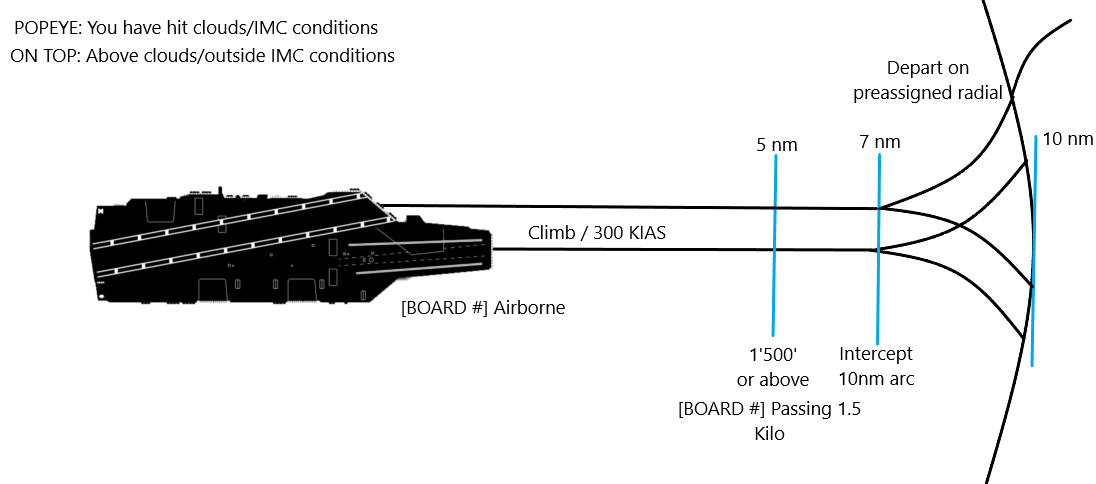
¶ 3.2 Arrival
Flying fifteen aircraft within 1000 feet of each other in pitch black conditions is a recipe for disaster, so it is paramount that all aircraft adhere to the given information as strictly as possible. To prevent impending catastrophe, aircraft will be assigned individual holding points and specific times at which they can approach the carrier for their landing attempt.
At 50 NM, begin the check-in call as if it was a standard CASE I call. The carrier will respond with new information, giving you precise orders that must be repeated so marshal knows you are listening correctly. For the sake of simplicity, vCSG-8 does not currently teach or expect members to know CV-2 approaches.
Marshal,
[Modex], marking mom’s[Bearing from CVN to aircraft]for[range], angels[current altitude], state[remaining fuel in pounds, divided by 1000].
Marshal, 302, marking mom’s One Five Zero for Fifty-Six, angels Two Two, state Six point Three.
[Calling Modex],[carrier code name]marshal. CASE III recovery, CV-1 approach, expected BRC[carrier current heading]. Altimeter[inches in mercury at the carrier].[Calling Modex], marshal on mother’s[carrier's radial bearing to marshal on]radial,[distance from carrier]DME, angels[altitude block to hold at]. Expected approach time[double digit time past the hour where you will commence towards the carrier.]
302, Lone Warrior marshal. CASE III recovery, CV-1 approach, expected BRC Three Three Zero. Altimeter Two Niner Niner Two.
302, marshal on mother’s One Eight Zero, Twenty-One DME, angels Six. Expected approach time Four Five.
302, marshal on mother’s One Eight Zero, Twenty-One DME, angels Six. Expected approach time Four Five.
302, readback correct.
If you hear either distance or altitude and not the opposite, add or subtract fifteen to get the answer. 21 DME - 15 = 6,000 feet.
When enroute to your holding position, it is paramount that you are at your designated altitude first and in excess of 20 DME from the carrier as a close second. Each aircraft must be at their assigned altitude within 30º to the left or 10º to the right of their assigned radial. Once all former conditions are met and the aircraft is within 10 NM of their holding position, inform marshal with the radio call [Modex], established angels [current altitude], state [remaining fuel in pounds, divided by 1000]. Marshal will readback your fuel state as confirmation that they heard your transmission.
302, established angels Six, state Five point Nine.
302, roger, state Five point Nine.
Perform a left hand holding pattern while waiting for your time to commence. A six minute holding pattern would include standard rate left hand turn for one minute, fly a two minute leg, complete another one minute standard rate turn, and fly a second two minute leg to reach your beginning point. Adjust this pattern as needed to arrive at your assigned marshal point at the correct time.
In a straight line at 250 knots, an aircraft will travel four nautical miles in 1 minute.
Any speed and any shape pattern is allowed so long as you maintain your designated altitude and do not exceed your designated holding distance.
When the time comes to commence, you must be at your assigned distance, altitude, and the correct speed of 250 knots. From here on out, all procedures require you to maintain 250 knots. This is incredibly important, for any plane that is slower than 250 knots may have the plane run into it from behind. Any aircraft faster than 250 knots may run into someone in front of them.
If you find yourself over or under 250 knots, return to the correct speed, do not attempt to counterbalance by slowing down or speeding up.
Correct speed, time, distance, and altitude all met, inform marshal you are commencing with the call [Modex], commencing, [altimeter inches mercury], state [remaining fuel in pounds, divided by 1000]. Marshal will respond to you with your radar distance from the carrier and the expected final bearing of the carrier’s landing area.[2]
302, commencing, altimeter Two Niner Niner Two, state Five point Zero.
302, radar contact Twenty DME, expected final bearing Three Two One.
302
While making your commencement call, start a descent rate of 4,000 feet per minute and continue this rate until you descend through 5,000 ft MSL. Slow your descent rate to 2,000 feet per minute and use the radio announce you have passed 5,000 ft MSL with [Modex], platform. This announcement serves to inform marshal or approach of your location and to alert yourself that you’re fast approaching the ocean. Once you approach 20 DME from the carrier, begin an arcing turn to align yourself with the given expected final bearing by 13 DME.
At some point after your commencement call, marshal will have ordered you to change your radio frequency to the carrier approach frequency. This hand off clears up the marshal frequency for the controllers, and allows you to concentrate on given instructions from the approach controllers and Landing Signal Officers (LSO).
302, switch approach.
302, roger.
Wait 10-15 seconds after switching to approach to prevent potentially stepping on any current transmissions!
After switching from marshal to approach, provide approach with your current distance and remaining fuel. Approach will confirm your transmission by responding with your modex and confirming the final bearing of the landing area.
[Modex], checking in[current distance from carrier], state[fuel remaining in pounds, divded by 1000].
302, checking in Fourteen DME, state Four point Six.
302, final bearing Three Two One.
¶ 3.3 Recovery and Bolter Pattern
If everything has gone correctly, your aircraft should arrive on the final bearing at or before 12 DME, at an altitude of 1,200 feet MSL, traveling at 250 knots. Configure your jet for landing at 10 DME.
To assist with a CASE III landing, utilization of the Instrument Carrier Landing System (ICLS) is encouraged. To ensure that a pilot has their system tuned to the proper frequencies and channels, approach will ask the incoming aircraft to “say needles”. This phrase is asking the pilot to respond with their aircraft’s position in relation to the flight path marker. If the pilot’s response is satisfactory for approach, they will tell the incoming aircraft to “fly bullseye”, or to continue on their way to the groove, and hopefully to a successful landing. In addition to this, the carrier has the Long Range Lineup System (LRLS) to provide lineup feedback. Red is left of centerline, green is right of centerline, and amber is centered lineup. The rate of the flashing light indicates how far off centerline the aircraft is.
302, say needles.
[Modex],[current position of needles, height first, azimuth second.].
302, up and on.
Once you reach 1.5 DME from the carrier, you should be flying based on your needles and the Improved Fresnel Lens Optical Landing System (IFLOLS), if not using the ACLS function of your aircraft. As opposed to a CASE I recovery, where you should call the ball before the LSO asks you, the LSO will instead assist you during a CASE III by reminding you to call at 3/4 DME with [Modex], call the ball. Should the weather be non-conducive to seeing the IFLOLS, utilize needles.
Standard [Modex], [airframe], Ball [fuel remaining in pounds, divided by 1000] call as if it were CASE I, and the LSO will provide you with standard corrective orders as if it were a CASE I.
Regardless of whatever reason that caused a failure to trap, maintain the final bearing of the carrier’s landing area while climbing back to 1,200 feet MSL. Raise your landing gear, select half or fully retracted flaps depending on your airframe, and increase speed back to 200 knots. If you’re not informed by approach control after your bolter, make a standard rate left turn at 4 DME and call [Modex], abeam when the ship passes by your 9 o’clock, at a distance of approximately 2 DME. After you abeam call, approach should slot you back into the landing pattern at either 4, 6, or 8 DME. If no call is given, begin your turn into the landing pattern at 8 DME.
If given the order to turn back in for a landing attempt at 4 DME, begin configuring for landing as you start your turn. Turning in at 6 DME means you start configuring halfway through your turn. With an 8 DME turn, only begin setting up for landing after completing the full 180º turn. From here, you should be slotted back into the landing pattern, on-speed, on altitude, and lined up with the final bearing.
¶ 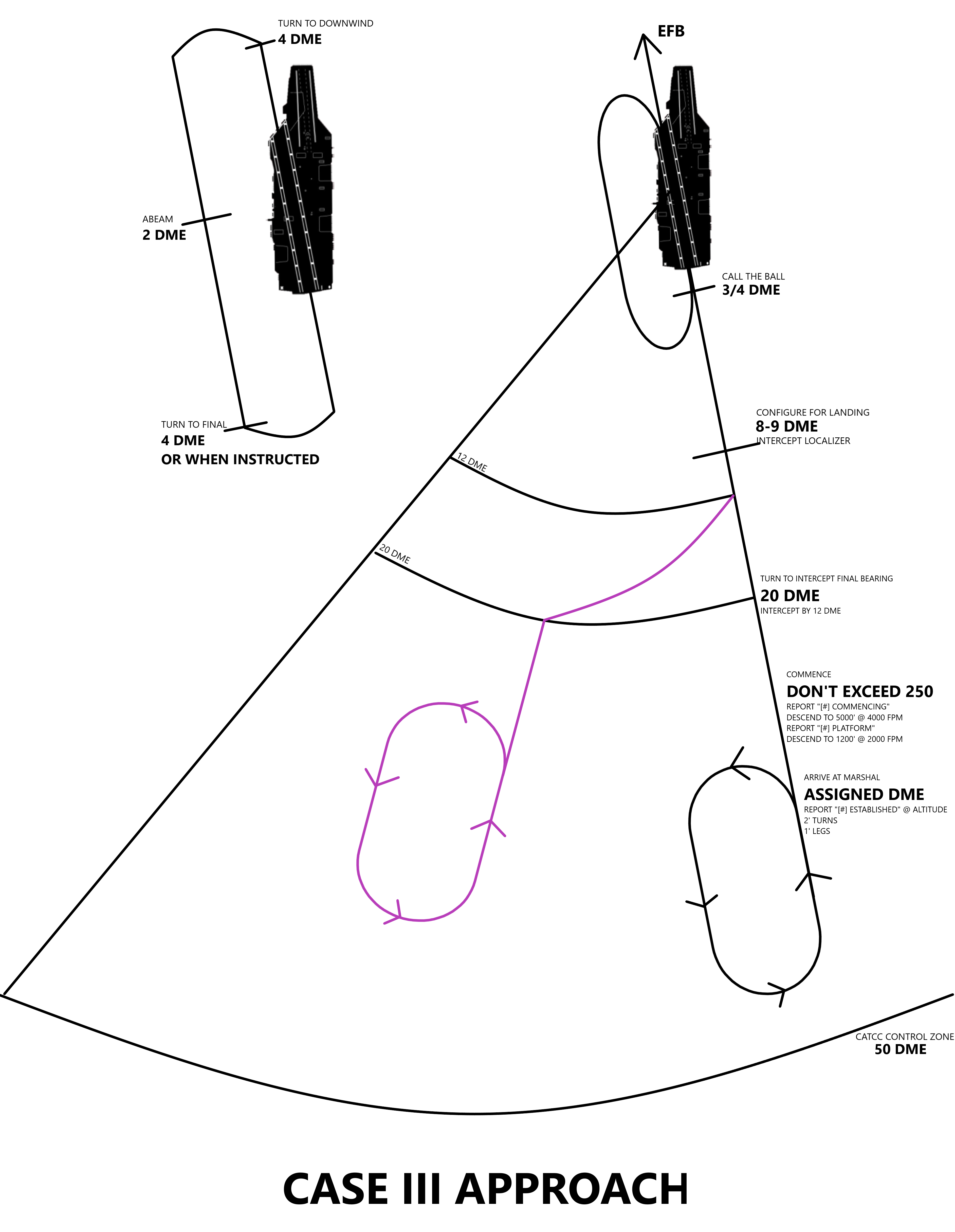
¶ IV - CASE II
The CASE II operations are essentially a hybrid of CASE I and CASE III operations, with launch following CASE III procedures at CASE I altitudes, and recovery following CASE III procedures until you are within sight of the boat, at which you transition to CASE I. To reiterate, CSG-8 does not expect its members to memorize or expect them to perform a CASE II on a regular basis.
¶ 4.1 Launch
When you’re in tension and the shooter is giving you the spool up command, request a launch from Carrier Departure on Preset 2.
321, ready to launch cat one.
To avoid issues with the carrier deck crew not responding and thus disabling ALL catapults, it is highly encouraged for Tomcats to utilize catapults One (starboard bow) and Three (starboard waist) only.
When given permission from Carrier Departure, signal for launch by turning on your exterior lights (if non-functional, salute). Once airborne, inform Carrier Departure with [Modex], airborne and continue flying the carrier’s heading while climbing at 300 knots at 500 feet.
If you encounter clouds or IMC conditions during the climb, inform Carrier Departure with [Modex], Popeye angels [cloud ceiling in thousands and hundreds of feet]. If clouds or IMC conditions cease while still tuned to Carrier Departure on Preset 2, give the call of [Modex], on top [end of clouds/IMC conditions in thousands and hundreds of feet].
402, Popeye angels three point three.
402, on top angels ten.
Passing 7 NM from the carrier deck, begin a turn to intercept the 10 DME arc in the direction of your prebriefed departure radial. When you reach said radial, turn onto the briefed heading and continue towards your rendezvous point.
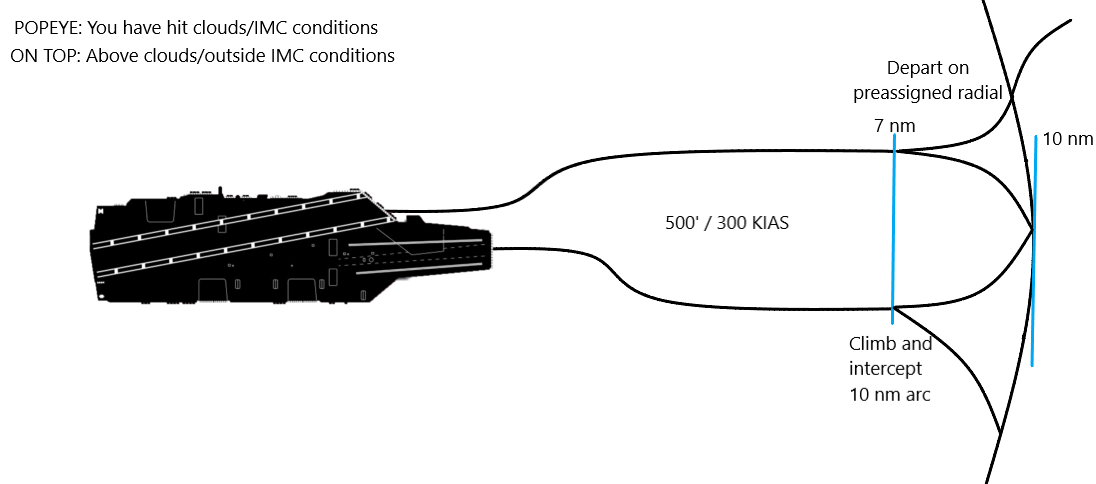
¶ 4.2 Arrival
Flying fifteen aircraft within 1000 feet of each other in non-conducive conditions is a recipe for disaster, so it is paramount that all aircraft adhere to the given information as strictly as possible. To prevent impending catastrophe, aircraft will be assigned individual holding points and specific times at which they can approach the carrier for their landing attempt.
At 50 NM, begin the check-in call as if it was a standard CASE I/III call. The carrier will respond with CASE III information, giving you precise orders that must be repeated so marshal knows you are listening correctly. For the sake of simplicity, vCSG-8 does not currently teach or expect members to know CV-2 approaches.
Marshal,
[Modex], marking mom’s[Bearing from CVN to aircraft]for[range], angels[current altitude], state[remaining fuel in pounds, divided by 1000].
Marshal, 302, marking mom’s One Five Zero for Fifty-Six, angels Two Two, state Six point Three.
[Calling Modex],[carrier code name]marshal. CASE II recovery, CV-1 approach, expected BRC[carrier current heading]. Altimeter[inches in mercury at the carrier].[Calling Modex], marshal on mother’s[carrier's radial bearing to marshal on]radial,[distance from carrier]DME, angels[altitude block to hold at]. Expected approach time[double digit time past the hour where you will commence towards the carrier.]
302, Lone Warrior marshal. CASE II recovery, CV-1 approach, expected BRC Three Three Zero. Altimeter Two Niner Niner Two.
302, marshal on mother’s One Eight Zero, Twenty-One DME, angels Six. Expected approach time Four Five.
302, marshal on mother’s One Eight Zero, Twenty-One DME, angels Six. Expected approach time Four Five.
302, readback correct.
If you hear either distance or altitude and not the opposite, add or subtract fifteen to get the answer. 21 DME - 15 = 6,000 feet.
When enroute to your holding position, it is paramount that you are at your designated altitude first and in excess of 20 DME from the carrier as a close second. Each aircraft must be at their assigned altitude within 30º to the left or 10º to the right of their assigned radial. Once all former conditions are met and the aircraft is within 10 NM of their holding position, inform marshal with the radio call [Modex], established angels [current altitude], state [remaining fuel in pounds, divided by 1000]. Marshal will readback your fuel state as confirmation that they heard your transmission.
302, established angels Six, state Five point Nine.
302, roger, state Five point Nine.
Perform a left hand holding pattern while waiting for your time to commence. A six minute holding pattern would include standard rate left hand turn for one minute, fly a two minute leg, complete another one minute standard rate turn, and fly a second two minute leg to reach your beginning point. Adjust this pattern as needed to arrive at your assigned marshal point at the correct time.
In a straight line at 250 knots, an aircraft will travel four nautical miles in 1 minute.
Any speed and any shape pattern is allowed so long as you maintain your designated altitude and do not exceed your designated holding distance.
When the time comes to commence, you must be at your assigned distance, altitude, and the correct speed of 250 knots. From here on out, all procedures require you to maintain 250 knots. This is incredibly important, for any plane that is slower than 250 knots may have the plane run into it from behind. Any aircraft faster than 250 knots may run into someone in front of them.
If you find yourself over or under 250 knots, return to the correct speed, do not attempt to counterbalance by slowing down or speeding up.
Correct speed, time, distance, and altitude all met, inform marshal you are commencing with the call [Modex], commencing, [altimeter inches mercury], state [remaining fuel in pounds, divided by 1000]. Marshal will respond to you with your radar distance from the carrier and the the ships BRC.[2:1]
302, commencing, altimeter Two Niner Niner Two, state Five point Zero.
302, radar contact Twenty DME, expected final bearing Three Two One.
302
While making your commencement call, start a descent rate of 4,000 feet per minute and continue this rate until you descend through 5,000 ft MSL. Slow your descent rate to 2,000 feet per minute and use the radio announce you have passed 5,000 ft MSL with [Modex], platform. This announcement serves to inform marshal or approach of your location and to alert yourself that you’re fast approaching the ocean. Once you approach 20 DME from the carrier, begin an arcing turn to align yourself with the given BRC by 13 DME.
At some point after your commencement call, marshal will have ordered you to change your radio frequency to the carrier approach frequency. This hand off clears up the marshal frequency for the controllers, and allows you to concentrate on given instructions from the approach controllers and Landing Signal Officers (LSO).
302, switch approach.
302, roger.
Wait 10-15 seconds after switching to approach to prevent potentially stepping on any current transmissions!
After switching from marshal to approach, provide approach with your current distance and remaining fuel. Approach will confirm your transmission by responding with your modex and confirming the BRC of the carrier.
[Modex], checking in[current distance from carrier], state[fuel remaining in pounds, divded by 1000].
302, checking in Fourteen DME, state Four point Six.
302, BRC Three Two One.
¶ 4.3 Recovery and Bolter Pattern
If everything has gone correctly, your aircraft should arrive on the final bearing at or before 12 DME, at an altitude of 1,200 feet MSL, traveling at 250 knots.
¶ 4.3.1 Transition to CASE I
At this point, the approach begins a transition to CASE I conditions as you should be out of the non-conducive weather. Once you have in the carrier in sight, notify CATCC when you have visual of the carrier with [Modex], see you at [distance], descend to 800 feet and accelerate to 350 knots for a carrier break. CATCC will request a state update, and switch you to tower frequency for the overhead break and landing
404, see you at Nineteen.
404, update state, switch tower.
404, state Three point Two.
You will then execute a normal overhead break as previously discussed in the CASE I section of this page. All procedures remain the same, from the break to the bolter pattern.
